What can be done with a 5-axis milling machine?
It may sound strange, but if the Renaissance artist had traded the hammer and chisel for a numerical control (CNC) and milling machine, we would have thousands of statues of David made from all kinds of materials today.
If you still have doubts that 5-axis milling is a real art form, please click here or here.
Whether you are sculpting a masterpiece out of marble or milling a blisk out of titanium – the basic principle is the same: You start off with a block of the material and remove the excess pieces until only the target object remains. Samozrejme, the details of this process are much more complicated, especially with 5-axis milling.
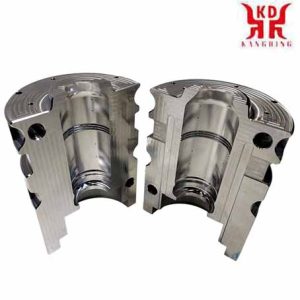
Applications of 5-axis CNC Milling
What is 5-axis CNC milling?
Put simply, with 5-axis milling, an object or the milling tool is moved simultaneously along five different axes by means of a CNC control. This enables very complex parts to be machined, which is why 5-axis technology has proven itself particularly in the aerospace industry.
Avšak, this is not the only reason that 5-axis technology has become widespread. Other factors are:
1 , A trend towards single-setup object processing (sometimes referred to as “done-in-one”) to reduce turnaround time and improve efficiency
2 , The possibility of preventing accidents at work by tilting the milling element or the milling table in a controlled manner, which also enables the process to be better coordinated with the geometry of the respective object
3 , The optimization of the tool life and the tool cycle as a side effect of the above-mentioned tilting function of the milling element or milling table by ensuring an optimal cutting position and a constant metal removal rate
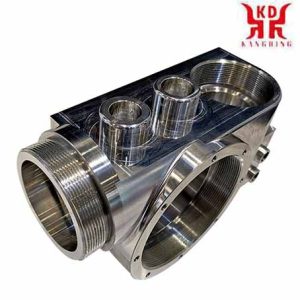
Functions of 5-axis CNC Milling
What about the axes in the 5-axis machining process?
We all know the story of Newton and the apple, ale existuje príbeh matematika a filozofa Reného Descarta podobne pochybného pôvodu.
Descartes bol v posteli (ako to robia matematici a filozofi) keď si všimol muchu bzučiacu cez jeho izbu. Uvedomil si, že polohu muchy v trojrozmernom priestore miestnosti dokáže opísať iba tromi číslami, reprezentované premennými X, Y a Z.
Toto je karteziánsky súradnicový systém, ktorý sa používa dodnes, viac ako tri storočia po Descartovi’ smrť. X, Y a Z teda pokrývajú tri z piatich osí 5-osového procesu obrábania.
Ale čo ďalšie dve osi?
Predstavte si priblíženie Descartovho letu uprostred letu. Namiesto toho, aby len opísali ich polohu ako bod v trojrozmernom priestore, môžeme opísať aj ich orientáciu. Keď mucha zmení smer, robí to rovnakým spôsobom ako lietadlo, ktoré sa pri manévrovaní nakláňa. Štvrtá os, A, opisuje svoju bočnú rotáciu okolo vlastnej osi ako os rotácie okolo X (z technického hľadiska nazývaný „valcovanie“.).
V nadväznosti na porovnanie lietadiel, vertikálny sklon mušky nahor alebo nadol opisuje piata os, B, ako os rotácie okolo Y (z technického hľadiska nazývané „prikyvovanie“.).
Pozorný čitateľ si nepochybne odvodí existenciu šiestej osi, C, otáčanie okolo osi Z. V našom príklade ide o horizontálnu rotáciu mušky doľava alebo doprava (z technického hľadiska nazývané „yaw“.).
Ak máte ťažkosti s vizualizáciou šiestich osí opísaných vyššie, nižšie uvedený diagram by mal slúžiť ako návod:
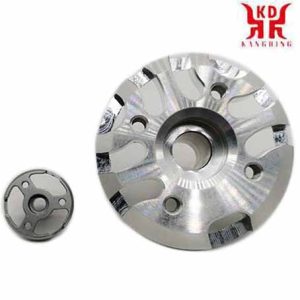
5-osové frézovanie skrine stroja
Osi A, B a C sú usporiadané abecedne tak, aby zodpovedali osám X, Y a Z podľa toho. Aj keď existujú 6-osové CNC stroje ako napr, portálová frézka Zimmermann FZ 100, 5-osové konfigurácie sú bežnejšie, keďže šiesta os zvyčajne neponúka takmer žiadne ďalšie využitie.
Posledná poznámka o konvenciách označovania osí: Vo vertikálnom obrábacom centre, osi X a Y zodpovedajú horizontálnej rovine, pričom os Z zodpovedá vertikálnej rovine. V horizontálnom obrábacom centre, osi Z a Y sú zamenené. Pozrite si diagram nižšie:
5-konfigurácie osí
Konkrétna konfigurácia 5-osovej frézky určuje, ktorú z troch osí otáčania používa.
Takže z. B. stroj s otočným stolom s osou A (otáčanie okolo osi X) a os C (rotating around the Z-axis), while a swivel head machine with a B-axis (rotating around the Y-axis) and a C -Axis (rotating around the Z-axis) is working.
Inside view of the swivel table of the 5-axis, vertical machining center of the Okuma MU-4000V
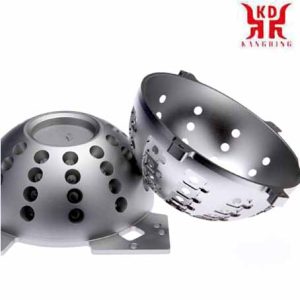
5-prototyp osovo frézovaného tienidla
The axes of rotation in swivel table machines are operated by the movement of the table, while swivel head machines operate their axes of rotation by rotating a spindle. Both types have their own advantages. Napríklad, swivel table machines offer larger processing chambers because the swivel spindle does not require significant space. Na druhej strane, swivel head machines can also process heavier parts because the table is always horizontal.
How many axes are required?
You may have heard of machining centers with seven, nine, or even eleven axes. Although so many additional axes seem hard to imagine, the explanation for such staggering numbers is actually quite simple.
“When you are dealing with machines that e.g. Napríklad, having more than one turning spindle increases the number of axes, ”explained Mike Finn, Senior Engineer Industrial Applications at Mazak America.
“For example, we have machines with an additional, second spindle and lower turrets. With these machines you have several axes: the upper turret has 4 axes and the lower turret has 2 osi, then you have two opposing spindles that also have 2 osi. Such machines can have up to 9 osi, ”continued Finn.
“The parts you make are still 5-axis parts,” added Wade Anderson, product specialist and sales manager at Okuma America.
“A component such. B. a valve for the aerospace industry could easily be manufactured in our vertical machining center MU-5000, a 5-axis machine. We could also machine this part on a multi-axis machine with a B rotation axis and two spindles for two C axes each, plus the standard X, Y and Z axes. There is also the lower turret, which provides you with a second X and Z axis. So there are more machining axes available, but the part itself will have the same geometry, ”said Anderson.
So how many axes are really needed?
As is so often the case in manufacturing, the answer to this question depends on the particular application. Finn gave the following example:
“A turbine blade is a free-form surface and can be very complex. The most efficient method of machining such an object is 5-axis machining, in which the tool is guided in a spiral around the profile of the turbine blade. 3-axis machining is possible by fixing the blade in a certain position and then machining the surface along three linear axes, but this is usually not the most efficient method. ”
Anderson agreed: “It depends on the geometry of the respective component whether you need a 3, 4 or 5-axis configuration.”
Avšak, it is important to note that the number of axes required depends on aspects that extend beyond the object to be processed directly. The target is the main factor, but it’s also about the long-term needs and goals of each customer, ”said Anderson.
“A customer could show me a part, such as a titanium bracket for aerospace technology, and I could say, ‘This is a perfect part for a 5-axis machining center,’ but the customer may already be planning to make parts in the future that can be processed better with one of our MULTUS U machines. This multi-function machine may not be as optimally suited as a 5-axis machining center with regard to the current component, but it offers the customer the possibility of turning, shaft or chucker work that can also be applied to future components. ”
“Another aspect to consider is the dimensions of the processing chamber,” added Finn. “What are the maximum dimensions of an object that you can insert into the machine without affecting tool and position changes? It’s about understanding what is possible with the system and what is not. ”
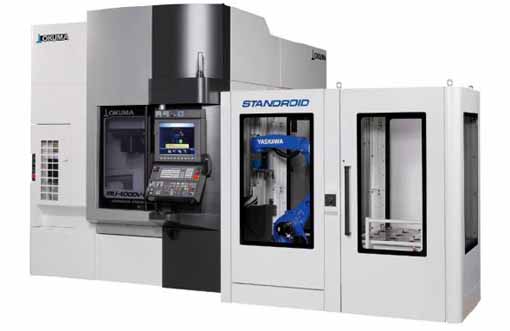
5-axis machining vs. 3D tlač
What are the advantages of 5-axis machining?
Choosing between 3-axis machining and 5-axis machining is a bit like deciding between a MacDonald’s quarter pounder and a T-bone steak; If cost is your only concern, then the first option is clearly a better option.
Avšak, if you compare 5-axis machining with 3 + 2-osové obrábanie, the decision is much more difficult.
5-axis vs 3 + 2-os
In order to understand the subject, it is important to understand the difference between 5-axis machining and 3 + 2-osové obrábanie. The former – also called continuous or simultaneous 5-axis machining, is accompanied by continuous adjustments to the alignment of the cutting tool along all five axes in order to keep the cutting nozzle optimally perpendicular to the workpiece.
Demo component made of 6010 aluminum produced on all 5 axes using a DMG MORI DMU50. Processing time: 13 minút.
With the latter, on the other hand – also called 5-sided or 3 + 2-osové obrábanie – a 3-axis program is executed in which the milling tool is fixed at an angle determined by the two axes of rotation. If the tool is realigned along the rotational axes between cuts, the process is called “5-axis indexed”; však, it is still one of the 3 + 2-axis machining processes.
3 + 2-axis demo component made of 6010 hliník, produced on a DMG MORI DMU50. Processing time: 7 minút.
The main advantage of 5-axis continuous machining over 5-axis indexed machining is speed, as the latter has to be stopped every time the tool is realigned, while the former does not.
In principle, však, it is possible to achieve the same results with both variants. (Readers who disagree are welcome to share their examples of parts that can only be machined with continuous 5-axis technology in the comments section below the article.)
It should also be mentioned that the speed advantage is bought at the price of increased tool activity, which is associated with increased wear and tear and an increased need for crash detection. This is one of the reasons why continuous 5-axis machining is more of a challenge from an operational point of view.
5-axis machining vs. 3D tlač
3D printing or additive or generative manufacturing – is currently a hot topic in the production world, especially with regard to the comparison with subtractive manufacturing processes such as 5-axis machining.
Although it is sometimes suggested that these two methods are in competition with each other – especially by hardcore 3D fans who claim that the 3D – Technology will soon turn the entire manufacturing industry upside down -, From a more moderate point of view, additive and subtractive manufacturing processes appear rather than mutually complementary technologies.
“I don’t think additive manufacturing will completely take over the manufacturing landscape, but I think it offers opportunities to make parts that couldn’t have been made in the past,” said Finn. “There are still many parts that require subtractive machining. For example parts that have a very low roundness tolerance. ”
“It is possible to bring an element to a near net shape without any problems, but this element still has to be reworked in order to achieve sufficient tolerance,” added Finn.
Does that mean that the future of manufacturing lies in a hybrid production system consisting of 3D printing and 5-axis CNC – perhaps with a built-in coordinate measuring machine to check the dimensions?
Anderson was not sure: “The real application of 3D printing outside of a laboratory environment is not to have a combined system, but for example an LMD system (Laser Metal Deposition; German: laser metal deposition) and simultaneously a rotary or Milling machines that both do what they do best and combine both units with automation. ”
The point behind two separate systems is better powder and chip management.
“The amount of powder you need on an LMD facility to make a 30-pound part can be anywhere from 150-300 pounds of titanium,” said Anderson. “When that is put into a machine that combines all of the functions, it is next to impossible to recover and reuse the powder.”
Inými slovami: 3D printing and 5-axis machining are less in competition with one another than they are complementary to one another. “I think that additive manufacturing can immensely reduce the amount of roughing involved in manufacturing,” concludes Finn.
How to get the most out of 5-axis machining
It is not uncommon for the advantages of 5-axis technology to not be used to a sufficient extent.
Anderson agreed: “That breaks the heart of companies like ours: When we see a company that goes all-in when purchasing their system and then uses only a fraction of the functions during commissioning for various reasons, napr. uses a multifunctional system with five or more axes such as a 3-axis system. Something like that happens again and again. ”
„Tento fenomén často súvisí s personálnou politikou spoločnosti,“ dodal Anderson. „Je to o školení a pochopení, ako používať systém. Niekedy je pre zodpovedných ťažké predstaviť si, ako sa dajú obmieňať štandardné aplikácie. napr. či by sa príslušný diel nedal opracovať aj hornou rotáciou, nižšia rotácia, hlavné vreteno a protivreteno súčasne v integrovanom procese. Možnosti sa niekomu môžu zdať ohromujúce a zahlcujú ich. ”
Význam 5-osového riadenia a softvéru
Hoci mať priemyselného mechanika s príslušnou kvalifikáciou významne prispieva k využitiu plného potenciálu 5-osového systému, riadiaci systém a softvér systému sú rovnako dôležité.
“With high-speed 5-axis machining, the servo drives on the system and the response time are very important in order to avoid erratic and inaccurate cuts during machining,” said Finn. “The system’s control system must be able to process the data quickly enough so that the tool can be guided over the object in a nice, smooth movement. You don’t want any jerky movements that can lead to deviations and irregularities. ”
“The software that creates the 5-axis programs must also be able to generate nice, smooth code so that the system can convert it into a smooth movement,” says Finn.
Choosing the right CAD / CAM package is therefore crucial in order to get the most out of your machine.
“Napríklad, when you’re doing aerospace blisks, you have to work with high-end programs,” said Anderson. “If, on the other hand, vyrábate malé hliníkové prvky vo forme odlievanej pod tlakom pre automobilovú spoločnosť a na ich montáž vám stačí vyvŕtať niekoľko otvorov do krytu motora, to je samozrejme nieco uplne ine.”
“Ak režete diely, pre ktoré CAM systém potrebuje vytvoriť špecifické rezacie programy, mali by ste investovať do CAM systému, ktorý je prispôsobený možnostiam vášho zariadenia,” dodal Finn.
Predchádzanie kolíziám v 5-osových systémoch
Pri vytváraní 5-osových frézovacích dráh, zvyčajne existuje dilema medzi vyššími rýchlosťami rezania a posuvu a minimalizáciou rizika nehôd a pádov. Našťastie, existuje množstvo softvérových nástrojov, ktoré môžu pomôcť neutralizovať tieto riziká.
“S naším softvérom na predchádzanie kolíziám, môžete nahrať 3D model dielu a nástrojov a program pred pohybom nástroja skontroluje akékoľvek riziko kolízie,” said Anderson. “Ak je vaše zariadenie správne vymodelované, zrážke sa zabráni pred začiatkom pohybu.”
„Na trhu je softvér, ktorý dokáže simulovať stroje,“ komentoval Finn. „Toto je mimoriadne dôležité, hlavne ked ide o drahsie diely. Nechcete kolízie, ktoré by viedli k tomu, že by ste museli časť zošrotovať, niekoho zraniť alebo poškodiť stroj. ”
“Vericut ponúka 3D virtuálny sledovací softvér, ktorý robí to isté, ale na offline počítači,” dodal Anderson. “Takže namiesto toho, aby bežal na riadiacom systéme v reálnom čase, nahrajte údaje o diele do Vericut a ten preskúma všetky vaše dráhy nástroja a uistí sa, že systém urobí presne to, čo od neho očakávate.”
Nástrojové snímače v 5-osových systémoch
Vysoká produktivita je výhodou 5-osového obrábania. ale tiež zvyšuje riziko chýb, ako napríklad B. Použitie poškodeného alebo nesprávneho nástroja. Jedným zo spôsobov, ako minimalizovať takéto chyby, je použiť snímač nástroja, ako je B. tento laser BLUM na DMG MORI DMU 50:
5-osová technológia: všetko v jednom prechode?
Pojem „Done in One“ je ušľachtilým ideálom výroby: Vložíte blok materiálu do stroja, spustite program a získajte úplne hotovú časť. Ako nulový čas nastavenia, Done-in-One je tiež cenným cieľom, aj keď to v konečnom dôsledku nemožno dosiahnuť bez kompromisov.
Bez ohľadu na túto skutočnosť, 5-axis machining brings us much closer to the goal than any other process, because even 3D printed parts require post-processing. In this context, the clamping technology represents a major limitation with regard to 5-axis machining.
“The clamping technology is immensely important in 5-axis machining,” says Anderson. “I can have the best system in the world, but if my clamping technology is lousy, I’ll never get the part out that I want at the end of the day.”
According to Finn, the key to overcoming this hurdle lies in the use of machines with more than five axes:
“Our INTEGREX machine z. B. can be equipped with counter spindles and a lower milling turret. This allows the parts to be cut on a spindle and then transferred to the sub-spindle to machine the rest of the part. This basically allows you to load a block of raw material and unload a finished part at the end. ”
The real art of 5-axis milling
5-axis machining offers significant advantages such as shorter throughput times, higher efficiency and longer tool life. Avšak, it is important to understand that these benefits cannot be realized by just purchasing the latest 5-axis machining center.
Mastering the art of 5-axis machining requires considering a variety of factors. On the subject, Anderson said the following:
“If you look at the customer’s problems, then technical problems in the course of processing are rather rare. Most of the time, the problems they are faced with revolve around things unrelated to the technology of manufacture, but rather training issues and personnel issues. preto preložte pracovný plán do adekvátnych príkazov riadenia systému alebo sa pred spracovaním uistite, že je k dispozícii dostatok nástrojov na dokončenie časti, ktorá sa začala. Okrajové časti procesu často predstavujú väčšiu výzvu ako technické problémy spojené so samotnou výrobou. ”
 English
English العربية
العربية 中文(漢字)
中文(漢字) Čeština
Čeština Dansk
Dansk Nederlands
Nederlands Suomi
Suomi Français
Français Deutsch
Deutsch Italiano
Italiano 日本語
日本語 ಕನ್ನಡ
ಕನ್ನಡ 한국어
한국어 Português
Português Русский
Русский Slovenčina
Slovenčina Español
Español Svenska
Svenska Türkçe
Türkçe

